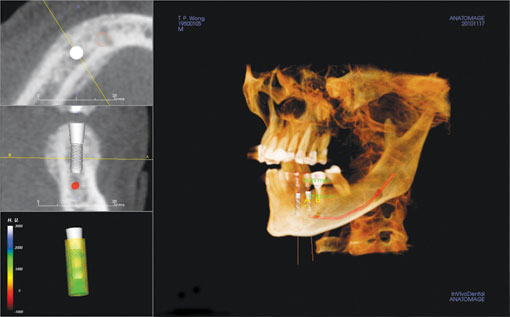Imaging Goes 3-D
By Dale Short

For a century, X rays have helped dentists diagnose and treat patients. Now they’re looking at teeth in a whole new way. “We’ve moved from traditional two-dimensional methods for measuring the patient’s head and neck to highly detailed 3-D imaging that reveals not only the bones but also the surrounding soft tissues,” says Chung H. Kau, D.M.D., UAB professor and chair of orthodontics, who is a leader in dental 3-D imaging research. “It’s the equivalent of having a virtual patient.”
The revolutionary new technology allows dentists to “see anatomical structures and reconstruct them in different views, and single out particular slices of the image, from the teeth up to the sinuses,” explains Michael S. Reddy, D.M.D., professor and chair of periodontics. “It’s especially useful for measuring structures of dental implants.”
Benefits for patients include better evaluations, less radiation than traditional X rays, and more personalized treatments. “It allows us to see how dental appliances affect the skeletal system in three dimensions,” says UAB orthodontist Christos Vlachos, D.M.D. New imaging techniques let dentists visualize how two appliances of similar design, but with different ways of action, will interact with a particular patient’s mouth. “We can then prescribe the appliance that’s best for a specific patient,” Vlachos explains. He adds that imaging also creates new horizons for treating genetic conditions such as cleft lip and palate.
Even the sculpting of teeth for implants, traditionally a time-consuming task done by hand, has received a digital upgrade. Dentists and technicians used to estimating the color of implants from a sheet of paint samples can now rely on a CAD-CAM (computer-aided design and computer-aided manufacturing) device to make a digital image of the prepared tooth and mill a perfectly matched restoration in minutes.
The technology has improved outcomes for computer-assisted surgery of the head, explains Peter Waite, M.P.H., D.D.S., M.D., professor of dentistry and surgery and the Charles A. McCallum Endowed Chair in the Department of Oral and Maxillofacial Surgery. “We use computational fluid dynamics to evaluate the airway before surgery and calculate exactly how much to modify the trachea. We’re also able to predict more accurately how much a particular patient will benefit from the procedure.”
The new technology gives patients new insights as well, Waite says. For the first time, patients can see what their faces will look like after surgery before they commit to the treatment.